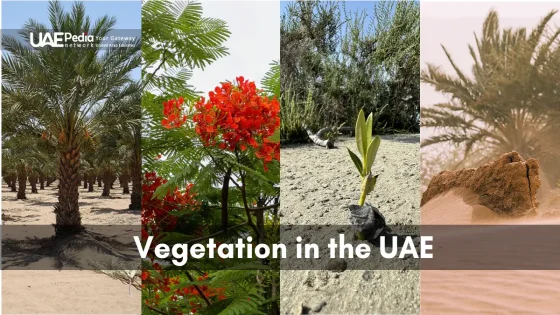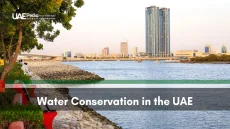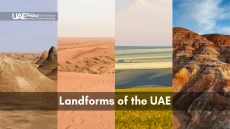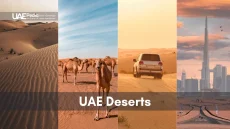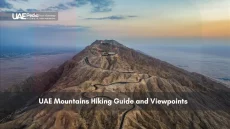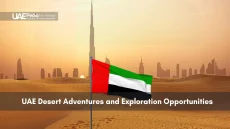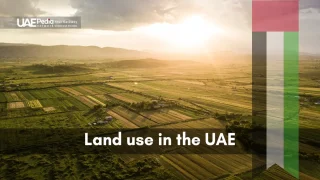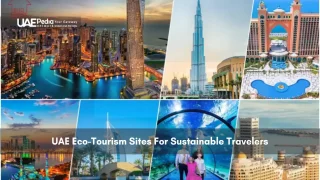When you think of the Emirates, glittering towers and luxury malls might spring to mind first. But what if we told you that hidden among the dunes are lush pockets of life older than the nation itself? These serene green retreats thrive in the desert’s embrace—a stark contrast to the cities’ neon glow.
For centuries, communities here have relied on ingenious water systems like the falaj—ancient channels that redirect underground springs to nourish date palms and crops. Today, these oases remain cultural anchors where heritage whispers through rustling leaves and shaded pathways.
We’re not talking about manicured resort gardens. These are living ecosystems where vibrant desert landscapes meet human resilience. Picture the surprise of stumbling upon a natural spring after miles of golden sands—a moment that captures the Emirates’ duality of innovation and tradition.
- Discover how desert havens balance modern life with timeless natural beauty
- Uncover the engineering marvels that sustain these green sanctuaries
- Learn why these spots matter to both locals and adventurous travelers
Exploring the Historical and Cultural Heritage of UAE Oases
Centuries ago, caravans traversed golden dunes, linking hidden settlements where water defied the arid climate. These hubs became more than rest stops—they were living libraries of innovation where cultures collided and thrived. Let’s unpack how two forces shaped this legacy: trade networks and water wisdom.
Sand Paths That Built Civilizations
Imagine merchants swapping spices from India for pearls from the Gulf—all under the shade of date palms. The abandoned watchtowers you’ll spot today once guarded routes connecting the Abu Dhabi region to Mesopotamia and beyond. As one historian notes:
“These trails didn’t just move goods—they transferred knowledge, faith, and culinary traditions across continents.”
Water Wizards of the Desert
No water? No problem. Enter the falaj—gravity-fed channels dug deep into aquifers. Communities across the Arab Emirates used these tunnels to turn parched earth into farmland. A single system could stretch 5 miles while maintaining precise slopes—an engineering feat rivaling modern pipelines!
| Feature | Trade Routes | Falaj Systems |
|---|---|---|
| Key Purpose | Exchange goods & ideas | Sustain crops & villages |
| Impact on Abu Dhabi | Boosted regional influence | Enabled year-round farming |
| Modern Legacy | UNESCO-recognized sites | Still irrigates 30% of farms |
This interplay of movement and moisture created the United Arab Emirates’ unique identity. From shared recipes to architectural styles, every palm grove whispers stories of resilience. Want to walk these ancient paths? We’ll show you where the past comes alive.
Essential Guide to UAE Oasis Locations
Let’s trade skyscrapers for shaded groves where time moves at nature’s pace. Three standout spots—Al Ain, Liwa, and Hatta—anchor the date palm belt, each with distinct charm. Want to explore the best spots? Our updated guide maps every twist in these leafy labyrinths.
Start with Al Ain’s UNESCO-listed groves. Over 147,000 date palms thrive here, their fronds whispering tales of Bedouin ingenuity. Local farmers still climb trunks to hand-pollinate flowers—a ritual unchanged for generations. Pro tip: Visit between July and September to taste fresh dates straight from harvest baskets.
Liwa’s golden dunes cradle smaller clusters, where emerald leaves contrast with burnt-orange sands. Use GPS coordinates (23.133°N, 53.766°E) to find hidden farms—many families welcome visitors for heritage-rich coffee sessions. Hatta’s mountain-backed groves? Perfect for combining cool dips in wadis with orchard strolls.
Planning your trip? November to March offers mild 75°F days. Mornings are golden hours for photography—watch sunlight filter through palm canopies like nature’s stained glass. Rent a 4×4 for remote regions, but stick to marked paths to protect fragile ecosystems.
These living museums prove date farming isn’t just agriculture—it’s a cultural lifeline. From irrigation techniques to festival traditions, every grove guards stories waiting to be tasted, touched, and remembered.
The Ingenious Falaj Irrigation System and Its Legacy
Beneath sun-scorched sands lies a hidden lattice of tunnels older than Dubai’s tallest skyscraper. These aren’t metro lines—they’re falaj channels, an ancient water network that turned barren earth into thriving palm groves. Imagine engineers 3,000 years ago calculating slopes by starlight to guide underground springs to thirsty roots!
Engineering Marvels of Underground Water Channels
Picture this: workers hand-digging tunnels 30 feet deep, using gravity to pull water across miles. One wrong angle? The whole system fails. Yet these time-tested aqueducts still irrigate farms today. A farmer near Al Ain once told us: “My grandfather taught me to listen for water’s song in the channels—it’s the heartbeat of our palms.”
Impact on Agriculture and Local Life
Without falaj, cities like Dubai might’ve remained tiny desert outposts. Date palms—the region’s original superfood—thrived thanks to reliable hydration. Families still gather at shared water分配 points, blending tradition with modern drip irrigation. As one engineer notes: “We’re now using satellite mapping, but the core principle? Still the same as Bronze Age problem-solvers.”
Want to experience this living history? Walk shaded pathways where cool air rises from ancient channels—a natural AC system before electricity. It’s not just engineering; it’s a love letter to survival, written in water and palm shadows.
Al Ain Oasis: A UNESCO World Heritage Treasure
Step into a living tapestry where mudbrick watchtowers rise above a sea of rustling date palms—this is Al Ain Oasis. Unlike static museums, this UNESCO-listed architecture breathes with daily life, blending 3,000-year-old irrigation channels with working farms. Here, the past isn’t preserved behind glass—it’s tended by hands that know each tree by name.
Date Palm Groves and Traditional Farming
Shade your eyes under a canopy of 147,000 palms, their trunks marked by generations of harvesters. Farmers still climb using woven date frond ladders, hand-pollinating flowers as their ancestors did. “We’re not just growing dates—we’re keeping stories alive,” shares a local grower. The falaj channels here feed 13 varieties of dates using organic methods unchanged for centuries—proof that ancient wisdom still sustains modern life.
Heritage Museums and Restored Forts
But the magic doesn’t stop at the groves. Al Jahili Fort’s sunbaked walls—once defending precious water sources—now house exhibits on Bedouin poetry and desert survival. Nearby, the Oasis Visitor Center decodes the significance of every mud wall and shaded alley. These sites don’t just display history—they let you trace your fingers along its weathered edges.
The landscape feels like a conversation between earth and ingenuity. Meandering paths reveal sudden clearings where date syrup simmers over open fires. Yet UNESCO protections ensure new constructions mirror traditional designs—a delicate dance between progress and preservation. As one architect notes: “Every restored archway sharpens our cultural edge, reminding us where innovation must root itself.”
Come morning light, when shadows stretch across clay buildings, you’ll grasp why this place earned its World Heritage status. It’s not just about saving old walls—it’s about honoring the living pulse beneath them.
Liwa Oasis: The Desert Retreat of Magnificent Dunes
Let your eyes adjust—what first seems endless sand reveals a hidden rhythm. Here, wind-sculpted dunes rise like frozen waves, some cresting over 300 feet. This is Liwa, where the desert doesn’t just exist—it performs.
Families here have turned survival into art. Picture orchards bursting with date fruit where GPS coordinates mark secret farms. “Our palms are family,” shares a farmer pouring cardamom coffee. “Their roots hold stories older than these sands.”
This place redefines “middle of nowhere.” Rustic homes blend into the landscape, their walls woven from palm fronds. Visitors often gasp at how people thrive here—until they taste fresh dates dipped in camel milk.
| Feature | Natural Wonder | Cultural Touchstone |
|---|---|---|
| Dune Height | Up to 300 ft | Symbolic of Bedouin resilience |
| Key Activity | Dune bashing | Date harvest festivals |
| Signature Scent | Petrichor after rare rains | Smoke from underground ovens |
Come sunset, the desert becomes a sensory playground. Walk barefoot up warm slopes as orange hues melt into indigo. Breathe air sweetened by fruit-laden branches—a perfume no luxury hotel can bottle.
“Liwa isn’t just a place on a map. It’s a way of remembering who we are.”
Adventure seekers and culture lovers find common ground here. Try sandboarding down ruby-red slopes, then share stories around fires where recipes pass through generations. This home among the dunes proves the desert isn’t empty—it’s full of life waiting to be lived.
Hatta Oasis: Nature, Adventure, and Cultural Insights
Craving mountain air in a land of endless dunes? Hatta swaps scorching sands for jagged peaks and freshwater pools—a plot twist in the Emirates’ desert narrative. This high-altitude retreat cradles a heritage village against rust-colored cliffs, where ancient irrigation channels meet adrenaline-pumping modern adventures. It’s where your morning could involve deciphering 200-year-old petroglyphs and your afternoon kayaking through turquoise waters—all within a UNESCO-recognized cultural landscape.
Heritage Village and Mountain Landscapes
Step into a living postcard at Hatta Heritage Village. Restored stone houses with palm-frond roofs showcase traditional tools, pottery, and falconry gear. “Every wall here holds stories of trade and survival,” explains a local guide. The surrounding Hajjar Mountains—a UNESCO World Heritage Site candidate—glow amber at dawn, their ridges framing trails once walked by Bronze Age traders.
Outdoor Activities and Water Sports
Swap museum quiet for the splash of paddles on Hatta Dam. Rent a kayak or hydrobike to explore mirror-still waters reflecting dramatic cliffs. Hikers tackle routes like the Hatta Loop, a 7.5-mile trail weaving through wadis and fossil beds. Pro tip: Book a guided sunset tour—the mountains transform into a fiery canvas while you sip Arabic coffee at a Bedouin-style camp.
| Experience | Cultural Connection | Adventure Level |
|---|---|---|
| Heritage Walk | Learn date preservation techniques | Easy |
| Mountain Biking | Follow ancient caravan paths | Challenging |
| Kayaking | Discover hidden rock formations | Moderate |
“Hatta isn’t just a day trip—it’s a crash course in balancing thrill with tradition.”
Whether you’re here for world heritage insights or heart-racing fun, this mountain jewel proves the desert holds more surprises than skyscrapers. Just don’t forget your swimsuit—those dam waters are irresistibly cool after a dusty hike.
Exploring Iconic Oasis Architecture and Fortifications
Imagine walls that double as history books—every brick etched with tales of desert traders and guardians. Across the Emirates’ sunbaked plains, structures like Al Jahili Fort stand as stone sentinels, their silhouettes guarding secrets of survival and splendor. These UNESCO World Heritage sites aren’t just relics—they’re classrooms where cultural heritage meets military genius.
Caravanserais and Defensive Watchtowers
Picture a 16th-century caravanserai: part fortress, part pit stop. Travelers once sheltered here beneath vaulted ceilings, camels resting in courtyards ringed by arrow slits. “These weren’t just buildings—they were lifelines,” explains a historian at the Sharjah Heritage Museum. Watchtowers like those near Al Ain still bear scorch marks from signal fires that warned of approaching raiders.
Jahili Fort’s honey-colored walls reveal dual genius. Its 30-foot ramparts deterred invaders, while shaded inner courtyards cooled date harvests. Today, UNESCO World recognition highlights how these designs balanced brute strength with delicate airflow systems—an ancient HVAC!
| Feature | Caravanserais | Watchtowers |
|---|---|---|
| Primary Role | Trade hub protection | Early warning system |
| UNESCO Status | 3 sites recognized | 5 towers preserved |
| Visitor Access | Guided tours only | 360° viewing platforms |
Modern explorers uncover surprises in restored chambers. Peer into a watchtower’s rooftop cistern—once filled via gravity-fed falaj channels—or trace your fingers over caravanserai walls etched with merchant graffiti. As one architect quips: “They built for eternity, but left room for personality.”
“Every stone here has two stories: one of defense, another of daily life. That’s the magic of our heritage sites.”
For visitors exploring these landmarks, the lesson is clear: beauty and brawn built this desert civilization. Whether marveling at geometric patterns in fortress gates or spotting sunset from a tower’s peak, you’re walking through chapters of human ingenuity.
Cultural Experiences in the Heart of the Desert
Trade the hum of city traffic for the rhythmic clatter of copper artisans shaping history. These desert hubs pulse with energy where ancient traditions meet modern curiosity—no velvet ropes, just living culture you can taste, touch, and barter for.
Vibrant Local Markets and Traditional Souks
Step into souks where sunlight filters through woven palm roofs, illuminating stalls piled with saffron and silver. Vendors still weigh dates using bronze age scales, their hands moving with muscle memory passed through generations. “Every spice here has a story older than these sands,” laughs a trader offering cardamom-infused coffee.
Bartering isn’t just accepted—it’s expected. Start at 40% of the asking price and let laughter grease the wheels. Pro tip: Fridays mornings buzz with locals stocking up—perfect for people-watching and scoring fresh camel milk chocolate.
Festivals, Crafts, and Culinary Delights
Time your visit with the Al Dhafra Date Festival, where farmers showcase 100+ date varieties. Watch women weave palm fronds into baskets using techniques unchanged since the bronze age, then join a hands-on halva-making workshop. The secret? Smoked samak leaves add earthy depth to this sesame sweet.
| Experience | Historical Roots | Visitor Tip |
|---|---|---|
| Spice Souks | Trading since 2000 BCE | Sniff before buying—fresh za’atar smells citrusy |
| Pottery Workshops | Clay designs from 3000 BCE | Get messy—local artisans love teaching beginners |
| Heritage Dinners | Recipes preserved in clay tablets | Ask for “majboos ma lahma”—spiced goat over rice |
As the sun dips, follow oud music to communal feasts under starry skies. A chef stirring lamb stew in a pit oven winks: “Our recipes are the original slow food—some pots simmer for days.”
“Visitors don’t just watch here—they dance, haggle, and get hennaed. That’s how memories stick to your soul.”
These gatherings aren’t performances—they’re invitations. Leave room in your suitcase for hand-painted coffee pots and stories richer than any souvenir.
Sustainable Tourism and Conservation Practices
What if every tourist footprint could help heal the earth instead of harming it? In these delicate desert ecosystems, smart water use isn’t just practical—it’s survival. Farmers now blend ancient falaj channels with drip irrigation tech, cutting water waste by 40% while keeping date palms thriving. “We’re not just growing trees,” says a conservationist. “We’re growing tomorrow’s shade.”
Cultural preservation walks hand-in-hand with eco-tourism here. Workshops teach visitors to weave palm fronds using Bedouin methods—crafts that fund clean energy projects. Night hikes led by local guides reveal how ancestors read stars for navigation, turning history lessons into carbon-neutral adventures.
Three conservation wins changing the game:
- Solar-powered camps that leave dunes untouched
- Habitat restoration bringing back native gazelles
- UNESCO partnerships training youth as heritage guardians
Tour companies now cap group sizes and use electric buggies in fragile areas. One family-run outfit shares profits to maintain ancient watchtowers. “When visitors respect our landscapes, they help write our next chapter,” explains a tour operator.
“True sustainability? It’s when your grandkids can taste the same dates from the same trees.”
Your visit matters. Choose operators with eco-certifications, stick to marked trails, and skip plastic bottles—many sites offer free refill stations. Together, we can keep these living museums blooming for centuries.
Local Agriculture and the Significance of Date Palms
Between the dunes and the date palms lies a secret symphony of survival. These towering trees do more than bear fruit—they create microclimates where animals, crops, and communities thrive against harsh odds. Farmers here aren’t just growers; they’re conductors orchestrating life in a land where water is gold.
Nurturing Biodiversity in Arid Landscapes
Walk through a working farm, and you’ll spot more than dates. Lizards dart between irrigation channels, while migratory birds nest in frond canopies. “Our palms are apartment complexes for nature,” laughs a third-generation grower. Ancient falaj systems sustain over 120 plant species—from medicinal herbs to citrus groves—proving biodiversity blooms where tradition meets ingenuity.
Three sites reveal this delicate balance:
- Al Ain’s experimental farms testing drought-resistant crops
- Liwa’s family orchards doubling as wildlife corridors
- Mountain villages preserving heirloom seed banks
Visitors gain hands-on experiences through sunrise harvests or beekeeping workshops. One farmer explains: “When tourists taste dates straight from the tree, they become partners in preservation.”
“This isn’t agriculture—it’s alchemy. We turn sweat and sun into ecosystems.”
The real adventure? Seeing drones monitor palm health while camels graze below—a dance of old and new. Many sites now offer “adopt-a-tree” programs, giving travelers an opportunity to leave roots deeper than footprints.
Immersive Guided Tours and Luxury Desert Escapes
Swap hotel concierges for star-gazing guides who decode desert secrets—this is where luxury meets the raw pulse of the sands. Imagine sipping cardamom coffee while Bedouin storytellers map constellations above your private tent. These journeys don’t just show you the desert—they let you live its rhythm.
Curated Experiences with Local Experts
Guides here aren’t reciting scripts. They’re fourth-generation camel herders sharing navigation tricks and family recipes. One operator offers moonlit archaeology walks where you’ll spot 2,000-year-old pottery shards—then enjoy a chef-prepared feast in a hidden wadi.
Three standout adventures:
- Sunrise falconry sessions with Emirati trainers
- Private dune dinners with live oud musicians
- Overnight stays in solar-powered eco-resorts
| Tour Type | Key Features | Duration | Price Range |
|---|---|---|---|
| Cultural Deep Dive | Hands-on date harvesting, henna art workshops | 6 hours | $150-$300 |
| Adventure Blend | Dune bashing, stargazing, luxury camping | Overnight | $500-$900 |
| VIP Private | Helicopter transfers, bespoke itineraries | Custom | $2,500+ |
Pro tip: Book sunset slots for golden-hour photography. Many operators offer last-minute deals—check social media for flash sales. “We design each tour like it’s for family,” shares a guide. “Because here, every guest becomes part of our story.”
Resorts like the Platinum Heritage Eco-Camp prove comfort and conservation coexist. Think plunge pools fed by natural springs and beds positioned for Milky Way views. Ready to trade room keys for adventure? The desert’s calling—and it serves dates with champagne.
Final Reflections on UAE Oasis Escapes
Beyond the skyscrapers and bustling cities lies a hidden layer of the Emirates—where ancient sands whisper stories of survival and splendor. Our journey through these desert sanctuaries reveals how centuries-old traditions thrive alongside modern adventures, proving that even the harshest landscapes cradle life’s most delicate balances.
From the rhythmic pulse of falaj channels to the rustle of date palms in Liwa’s dunes, every grove teaches a lesson in resilience. These spaces aren’t just photo stops—they’re living classrooms where cultural heritage and raw nature write joint survival manuals. Farmers, historians, and hikers alike find common ground here, united by awe for landscapes that defy the odds.
Preserving these treasures demands more than admiration—it requires action. Sustainable tourism practices and community-led conservation ensure future generations will taste fresh dates under the same shaded canopies. Yet the real magic? These sites invite you to leave lighter footprints while carrying richer memories.
Ready to swap screens for starry skies and sand-carved trails? Pack your curiosity, respect local rhythms, and let the desert’s quiet wisdom reshape your perspective. Share your discoveries, sip cardamom coffee with growers, and remember: every visit becomes part of the story these sands will tell tomorrow.
Al Ain Oasis earned UNESCO status for its 3,000-year-old falaj irrigation system, which transformed arid land into thriving date palm groves. It’s a living museum of sustainable agriculture, traditional mud-brick forts like Jahili Fort, and a testament to the region’s Bronze Age ingenuity.
Liwa sits at the edge of the Rub’ al Khali (Empty Quarter), home to the world’s tallest dunes. Beyond epic desert vistas, it’s the cultural heartland of the Bani Yas tribe and a hub for date farming. Think adrenaline-packed dune bashing by day, starlit Bedouin-style feasts by night.
Absolutely! Sites like Al Ain and Mazyad Oasis still use these underground channels. Guided tours let you walk alongside date plantations fed by 1,000-year-old waterways—some routes even pass restored watchtowers and caravanserais where traders once rested.
Hatta blends heritage and adventure. Kayak in turquoise dams, bike through mountain trails, or explore the restored Heritage Village. Kids love feeding goats at local farms, while parents soak in views of the Hajar Mountains’ jagged peaks.
Aim for October to March when temperatures dip below 30°C (86°F). Mornings are ideal for exploring palm groves, while evenings are perfect for desert safaris. Summer visits? Stick to early mornings and shaded museum tours.
Date palms create microclimates that shelter figs, citrus trees, and migratory birds. Farmers still grow heirloom crops like mangoes and alfalfa using falaj water, while conservation projects protect endangered species like the Arabian tahr near Hatta.
Yes! Luxury resorts like Qasr Al Sarab in Liwa offer private villas with dune views. For a cultural twist, book a night in Al Ain’s eco-lodges or Hatta’s glamping domes—stargaze from your bed or join guided sunrise walks through the groves.


